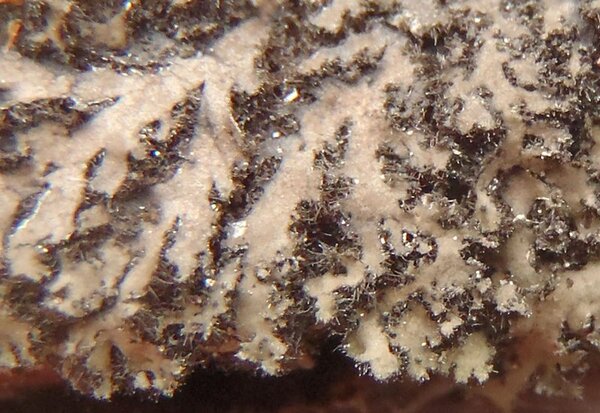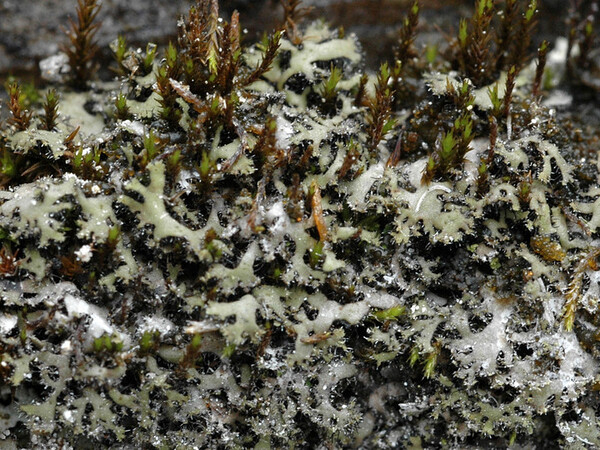Phaeophyscia kairamoi (Vain.) Moberg
Symb. Bot. Upsal., 22, 1: 40, 1977. Basionym: Physcia kairamoi Vain. - Meddeland. Soc. Fauna Fl. Fenn., 46: 3, 1921.
Synonyms: Phaeophyscia nadvornikii (Frey & Poelt) N.S. Golubk.; Physcia karakorina Poelt; Physcia nadvornikii Frey & Poelt
Description: Thallus foliose, heteromerous, dorsiventral, forming regular to usually irregular, up to 4 cm wide rosettes, several thalli often merging to cover larger surfaces. Lobes partly imbricate, 0.5-1.5(-2) mm wide, rarely wider, often slightly concave near the more or less ascending lobe tips, the margins mostly dissected into small, ciliate, isidia-like lobules. Upper surface grey to mostly grey-brown, epruinose but sometimes with a whitish grey, patchy epinecral layer, with sparse, hyaline to blackening cortical hairs (tending to fall off easily) and granular to irregularly lobulate isidia arranged in primarily marginal clusters, usually bearing hairs. Lower surface black, sometimes paler at lobe-ends, with simple, black rhizines. Upper and lower cortex paraplectenchymatous; medulla white. Apothecia rare, lecanorine, up to 3 mm across, sessile, with a dark disc and a usually entire thalline margin that often bears a dense corona of rhizines. Epithecium brown; hymenium and hypothecium colourless; paraphyses slender, often forked in upper part, the apical cells clavate, with a thin dark cap. Asci 8-spored, clavate, the K/I+ blue tholus penetrated by a faintly amyloid apical cushion with parallel or diverging flanks, the wall K/I-, surrounded by a K/I+ blue outer layer, Lecanora-type. Ascospores 1-septate, brown, ellipsoid, (20-)23-28(-34) x (8-)10-14(-15) µm, Physcia-type, often poorly developed. Pycnidia black, rather common. Conidia ellipsoid. Spot tests: cortex and medulla K-, C-, KC-, P-, UV-. Chemistry: without lichen substances.
Growth form: Foliose, narrow lobed
Substrata: bark and rocks
Photobiont: green algae other than Trentepohlia
Reproductive strategy: mainly asexual, by soredia, or soredia-like structures (e.g. blastidia)
Commonnes-rarity: (info)
Alpine belt: extremely rare
Subalpine belt: very rare
Montane belt: extremely rare
Dry submediterranean belt: absent
Humid submediterranean belt: absent
Padanian area: absent
pH of the substrata:
1 2 3 4 5
Solar irradiation:
1 2 3 4 5
Aridity:
1 2 3 4 5
Eutrophication:
1 2 3 4 5
Poleotolerance:
0 1 2 3
Altitudinal distribution:
1 2 3 4 5 6
Rarity
absent
extremely rare
very rare
rare
rather rare
rather common
common
very common
extremely common
Loading data...
Occurrence data
Predictive map
Growth form: Foliose, narrow lobed
Substrata: bark and rocks
Photobiont: green algae other than Trentepohlia
Reproductive strategy: mainly asexual, by soredia, or soredia-like structures (e.g. blastidia)
Commonnes-rarity: (info)
Alpine belt: extremely rare
Subalpine belt: very rare
Montane belt: extremely rare
Dry submediterranean belt: absent
Humid submediterranean belt: absent
Padanian area: absent
pH of the substrata:
| 1 | 2 | 3 | 4 | 5 |
Solar irradiation:
| 1 | 2 | 3 | 4 | 5 |
Aridity:
| 1 | 2 | 3 | 4 | 5 |
Eutrophication:
| 1 | 2 | 3 | 4 | 5 |
Poleotolerance:
| 0 | 1 | 2 | 3 |
Altitudinal distribution:
| 1 | 2 | 3 | 4 | 5 | 6 |
Rarity
absent
extremely rare
very rare
rare
rather rare
rather common
common
very common
extremely common
Loading data...
Occurrence data
Predictive map









